Learn how to make your own gluten-free sourdough starter from scratch at home. All you need is some gluten free flour, water, and a bit of time to start creating delicious sourdough products.
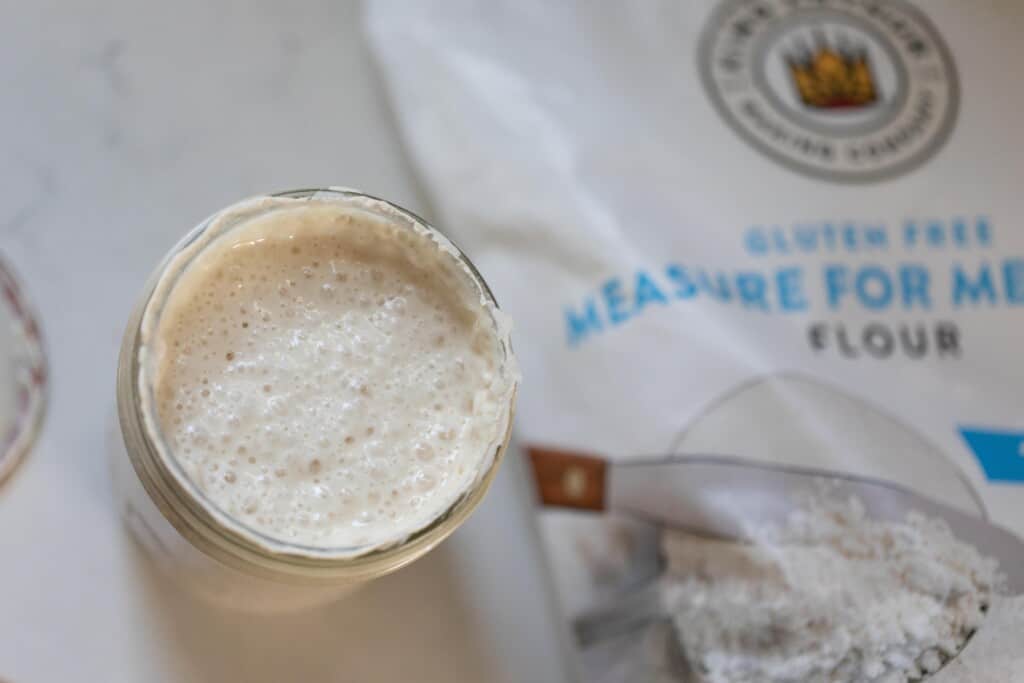
You may be familiar with my deep love for fermented grains, but I’m also frequently asked about creating a gluten-free sourdough starter.
There are many people that cannot tolerate regular gluten-containing grains, even when fermented. Yet, they still want to experience the deliciousness of sourdough.
Enter a gluten free sourdough starter. Same process, but made with gluten free grains like buckwheat, rice, teff, sorghum, etc.
It takes a little trial and error. At one point, I couldn’t really tell if my new starter was really working, so I made my sourdough rolls with my new GF starter and regular, freshly ground wheat flour and they turned out nice and fluffy.
So, it was clearly working, even though it wasn’t quite as bubbly as what I’m used to. So take a mental note for that when you are creating your own gluten free sourdough starter recipe.
Once I knew it was ready, I could start creating gluten free sourdough products. The sky’s the limit to what you can create. Check out some ideas below.
One of my favorite ways to use this recipe is to make some gluten free sourdough pancakes. Super yummy and easy breakfast everyone will love.
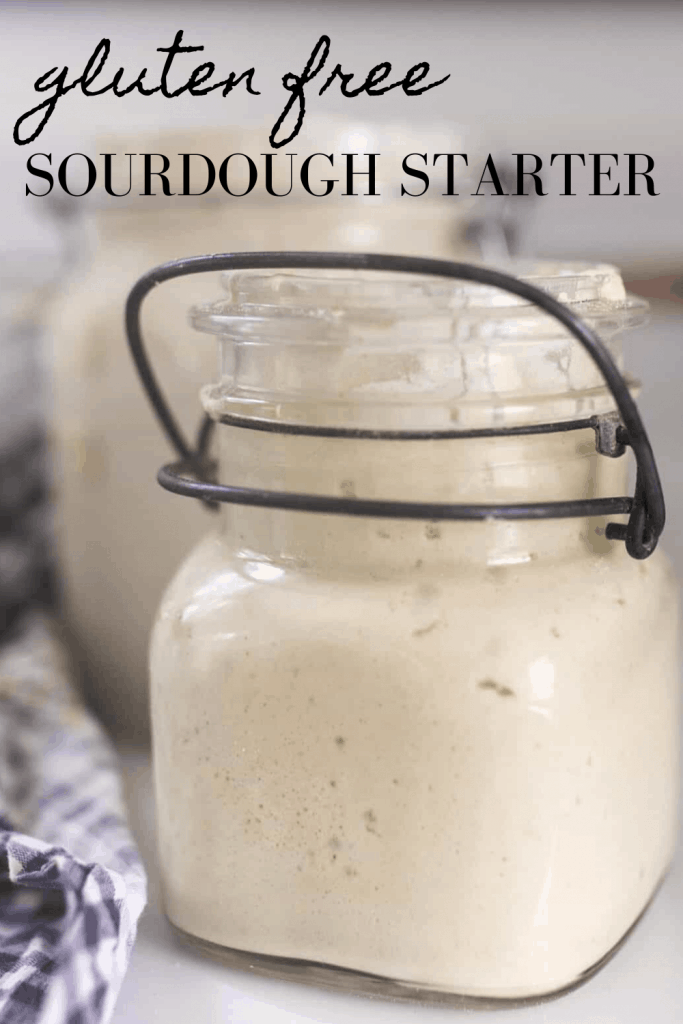
Tips For Making A GF Sourdough Starter
- Since gluten free grains tend to be more expensive than regular grains, I used less buckwheat or a gluten-free flour blend (like King Arthur one-for-one all purpose flour) to create my starter than I normally would making a starter.
- It may take a little longer for your gluten-free starter to take off and really start to get bubbly, especially if you use buckwheat.
- I hate wasting food, especially during a time like we’re experiencing now. When you’re discarding and feeding your starter, you can set your discard to the side in a covered bowl in the refrigerator. Once you have enough, you can use it in some sourdough discard recipes. You can also toss it in the compost. Up to you!
- Use filtered water, spring water, or water that doesn’t have chlorine in it because chlorine can inhibit the growth of the good bacteria. Tap water usually contains a significant amount of chlorine so if you are having issues, this could be why.
This post contains affiliate links, which means I make a small commission at no extra cost to you. See my full disclosure here.
What is gluten free sourdough starter?
A gluten free sourdough starter is a combination of gluten free flour, water, and captured wild yeast from the environment that can be used in recipes to naturally rise dough without commercial yeasts or leaveners.
It is the same as a “regular” wheat sourdough starter, but the glutinous grains are replaced with gluten free grains.
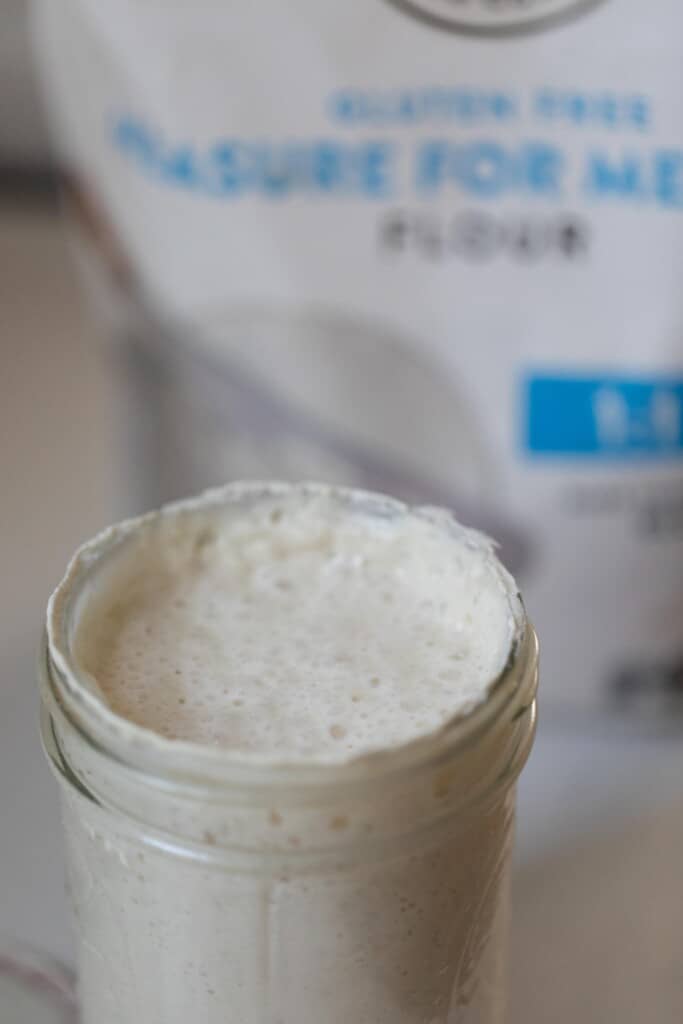
GF flours you can use:
You can actually use a variety of different flours or even a combination of flour when creating your starter.
- Buckwheat
- Brown rice flour
- Sweet rice flour
- Sorghum flour
- Gluten free flour blends like Bob’s Redmill or King Arthur for example. Some people suggest not using a gluten free 1 for 1 type of flour due to the fact that they contain starches and gums. I have tried it with the King Arthur brand and it worked really well.
- Teff
- Millet
- You can also make a starter out of potatoes! Check out that recipe here.
Flours not to use:
- Oat
- Quinoa
- Amarath
Tools you may need:
Glass bowl or large glass jar – You want to use non-reactive supplies. Glass is the perfect option for this. While technically stainless steel is non reactive, most sourdough enthusiasts would recommend avoiding all metals.
Wooden spoon or silicon spatulas are your best option. Some people say to stay away from metal utensils when mixing starter, but I’ve never had an issue with that.
Towel, coffee filter, piece of cloth, or even a paper towel (although not my favorite option as it tends to stick to the lid).
Berkey water filter – Sourdough doesn’t like chlorine as it can inhibit the wild yeast and good bacteria from flourishing. Filtering the water is a simple way to combat this, plus drinking filtered water is much healthier.
FAQ
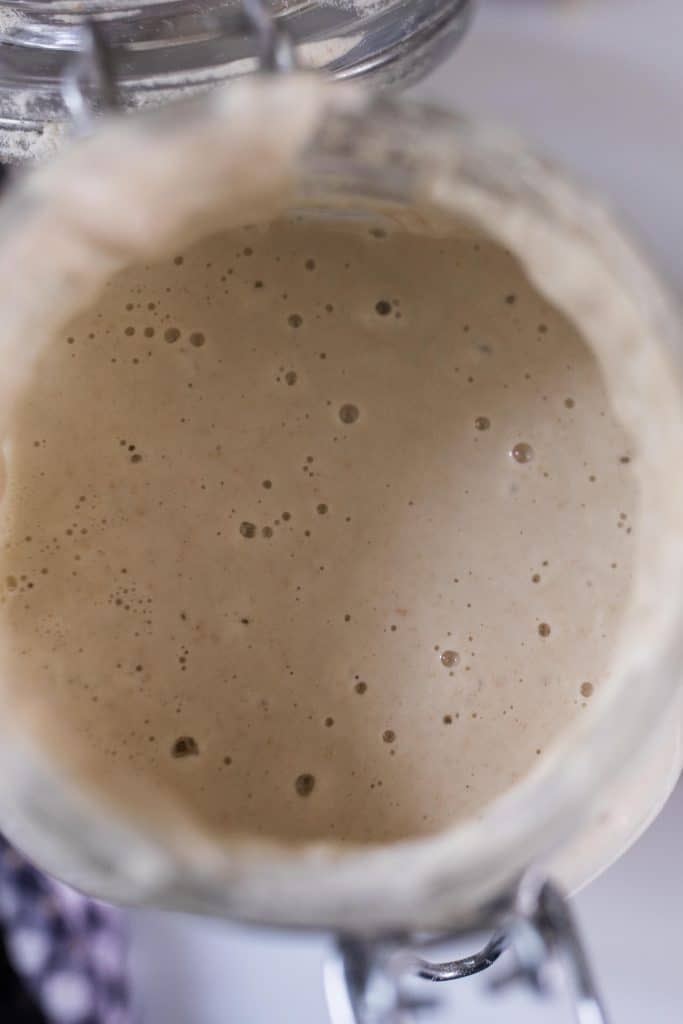
Is a sourdough starter gluten free?
Regular starter made with wheat flour is not. Even though it contains less amounts of gluten through the process of fermentation, it does still contain some. Using a gluten free flour from the beginning will give you a true gluten free sourdough starter.
Is Sourdough OK for gluten intolerance?
This depends on the type of sensitivity you have. Those who have celiac disease cannot have any amount of gluten, so they will not be able to tolerate sourdough products made with regular flour.
However, they would be able to tolerate gluten free sourdough products made with gluten free sourdough starter.
Some people with a gluten sensitivity may be able to tolerate long fermented (8-24 hours or longer) sourdough products. This is because during the fermentation process the wild yeasts, bacteria, and lactic acid breaks down the gluten (while making it more sour), making the end product contain less gluten that is easier to digest than non-fermented wheat products.
Always consult a medical professional before trying.
What type of flour is best for a gluten free sourdough starter?
You can use any of these gluten free grains: buckwheat, teff, millet, rice, sorghum.
I have also seen on King Arthur Flour and Bob’s Red Mill websites that they have recipes using their 1-for-1 gluten free flours.
White or brown rice flours may yield a more bubbly starter.
I used buckwheat for my starter, because many of the other flours were sold out, and I could get my hands on it quickly.
Another option would be to combine half buckwheat flour with half rice flour, or any combination of the approved flours.
Can I feed my sourdough starter with gluten free flour?
If you have a regular, glutenous starter, I wouldn’t recommend just feeding it gluten free flour. While you definitely could do this, it would still contain some gluten, so your sourdough creations would not be completely gluten free.
Can you convert sourdough starter to gluten-free?
This is definitely possible. While it would still contain trace amounts of gluten, eventually after enough feeding with gluten free flour, a regular starter would be transformed into a “gluten free sourdough starter.” But, then again may have traces of wheat still contained in the gf starter. So if you have celiac or an allergy I wouldn’t recommend going this route.
What is the liquid on top?
Sometimes a liquid forms on top. This is called hooch. This will form when it has been too long since it was fed last, or if your starter isn’t very strong. It’s your starter telling you it is hungry.
You can just pour it off and feed the starter.
Why do you discard sourdough starter?
Removing half of the mixture ensures that the right amount of flour and water is feeding the growing colony of beneficial yeast. If you weren’t discarding half, the 1/4 cup of flour wouldn’t be enough to feed them on days three and four.
You would end up with a lot of extra, immature starter by the end of the process. It wouldn’t be able to make bread or cinnamon rolls rise.
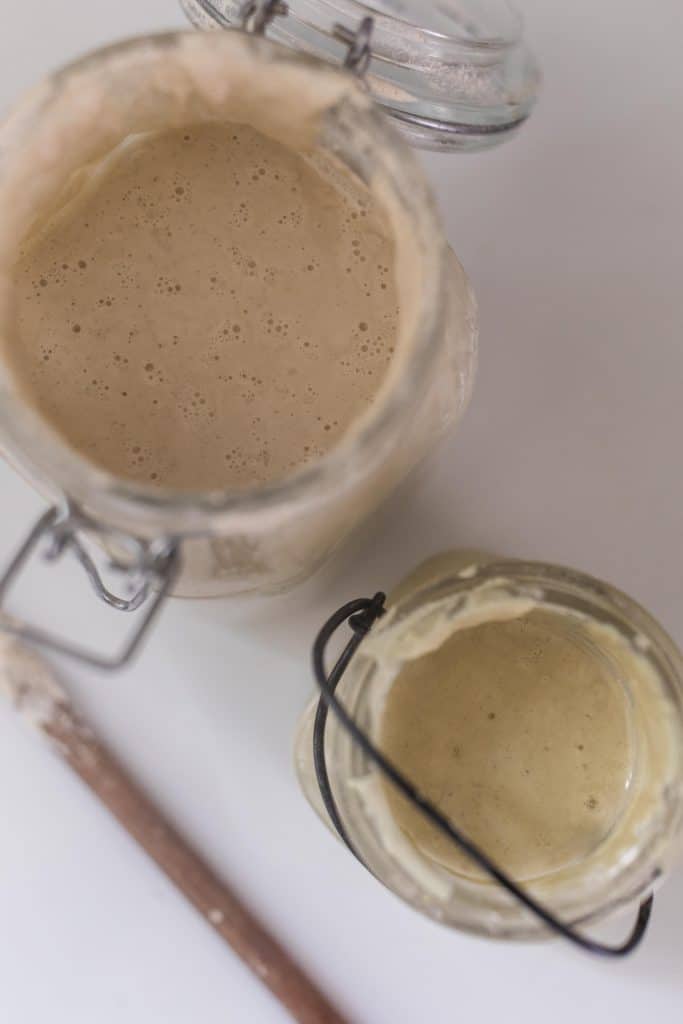
How To Make A Gluten Free Sourdough Starter From Scratch
Day 1: Mix Flour And Water Together
- Mix 1/4 cup flour and 1/4 cup filtered water in a clean jar or glass bowl.
- Stir vigorously, scraping down the sides of the jar and incorporating everything.
- Place a clean tea towel or coffee filter over the bowl or jar with a rubber band and set aside at room temperature or a warm place for 24 hours.
This is a 100% hydration starter. Meaning when you continue to feed the starter you will use 1 part flour, 1 part water, 1 part starter.
Day 2: Discard Some Starter, Then Feed
- The next day, discard half of the starter.
- Add 1/4 cup gluten free flour, 1/4 cup water, stir vigorously, and cover.
- Set aside for 24 hours.
Day 3, 4, & 5: Discard Some Starter, Then Feed
- Repeat the day two instructions for days three, four, and five:
- Discard 1/2 of the starter.
- Feed 1/4 cup gluten free flour and 1/4 cup water. Stir vigorously. Scrape down the sides.
- Cover and set aside for 24 hours.
Day 6 & 7:
On days six and seven, do the same discarding and feeding as the other days, but feed it every 12 hours instead of every 24.
By day seven, there should be enough beneficial bacteria and yeast present to make some sourdough goodies like biscuits, or muffins. But it may not be active enough to make, say bread. It can take a couple more weeks before it is really active enough to create gluten-free bread.
How can you tell it is ready?
You will know it’s ready if it has lots of bubbles, and doubles in size after a few hours when fed.
Unfortunately, gluten free starter doesn’t pass the float test like a regular wheat active starter would. So determining if it is ready will be based on appearance and if it is bubbly and doubling in size.
Maintaining And Feeding Your Starter:
If you are planning to bake a lot with your starter, you can leave it on the counter and feed it every 12 hours equal parts GF flour and water. Or else, place it in the fridge with a lid and feed every 7 days.
When you are ready to bake with it, remove it from the fridge, feed it, and then wait 4-12 hours (until it is about doubled in high and is bubbly). Happy baking.
How much flour and water should I feed my starter?
If you have a cup of starter, you will need to feed it 1 cup of flour and 1 cup of water. If you have 1/2 cup of starter, then you can feed it 1/2 cup flour and 1/2 cup of water.
Does that make sense? You don’t want to feed 1 cup of starter 1/4 cup of flour and water. It will be hungry.
If you have too much starter, discard it or use it in discard recipes.
Once your starter is well established, you don’t need to always discard it before feeding it. You can either use the discard in recipes or feed it. As long as it is fed enough flour and water, it should stay nice and happy.
If you are planning to only bake once a week or so, you can store your gluten free starter covered in the fridge and feed it equal parts water and flour once a week.
Pull the starter out of the fridge to feed it about 12 hours before you plan to use it.
What to make with a gluten free starter:
- Pancakes
- Muffins
- Cake
- Bread
- Scones
- Brownies
- Cookies
- And more
Find More Gluten Free Recipes Straight From The Farmhouse Kitchen:
- Sourdough Buckwheat Pancakes
- Homemade Gluten Free Granola Bars
- Fudge Coconut Flour Brownies
- Coconut Flour Lemon Poppyseed Muffins
- Homemade Rustic Granola
- Stove-Top Coconut Oil Popcorn
If you make this recipe and love it, I would love it if you gave it 5 stars! Tag me on Instagram @farmhouseonboone with your delicious creation.
Gluten Free Sourdough Starter
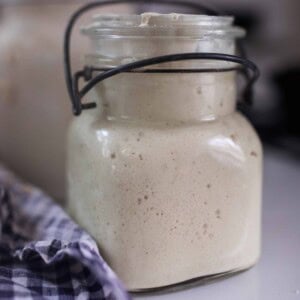
Equipment
Ingredients
- Flour, buckwheat, teff, millet, rice, or sorghum. You may even be able to use a gluten free one-to-one flour blend.
- Filtered water
Instructions
- Day 1: Mix Flour And Water Together
- Mix 1/4 cup flour and 1/4 cup filtered water.
- Stir vigorously, scraping down the sides and incorporating everything.
- Place a clean tea towel over the bowl and set aside for 24 hours.
- Day 2: Discard Some Starter And Feed
- Discard half of the mixture.
- Add 1/4 cup gluten free flour, 1/4 cup water, stir vigorously, and cover.
- Set aside for 24 hours.
- Day 3, 4, & 5: Discard Some Starter And Fee
- Repeat the day two instructions for days 3-5.
- Cover and set aside for 24 hours.
- Day 6 & 7:On days six and seven, do the same discarding and feeding as the other days, but feed it every 12 hours instead of every 24.
- By day seven, your starter should contain enough wild yeast and beneficial bacteria to be able to bake with.
Notes
- It may take a little longer for your gluten free sourdough starter to take off and really start to get bubbly, especially if you use buckwheat.
- It is best to use filtered watered when feeding and maintaining your starter. I use a Berkey Water Filter, but any filtered water will do. The chlorine in city water may kill or inhibit the wild yeast and good bacteria growth.
Nutrition information is automatically calculated, so should only be used as an approximation.










I’m on day 5 of my gluten free starter and it’s the consistency of jello when I go to stir it. When I stir it, it breaks up like normal but I was curious if that was normal? I’m using a gluten free flour blend that has miler flour, rice flour, and sorghum flour in it ( it also contains xanthum gum).
Also, should I be saving 1/4c of the starter each time I discard and then adding 1/4 cup of both water and flour so it is 1:1:1 ratio?
Yes, you can try a 1:1:1 ratio! I like to have a consistency that is a little bit thicker than pancake batter.
What do you do with the starter after day seven? Do you feed and discard like day 5-6 until day 14? Then I’m ready to bake bread.
If your starter is active at day 7, you can begin baking with it.
I’m looking forward to making your gluten-free sourdough starter. In the meantime, I was hoping to make your recipe for Fudge Coconut Flour Brownies listed on the GF sourdough starter page, but the link is broken and I couldn’t find it using the search feature. Would you kindly point me in the direction of the recipe?
Thanks in advance!
Celeste
We are working on editing and publishing new posts. It’s possible that recipe has been removed temporarily.
Hi
Thank you for your recipe.
I just want to ask as this is the first time that I am making a starter.
You say on day 2 to feed it – am i feeding it 1/4 cup flour and water or is it something else?
Thank you in advance
That’s right. Just make sure you are discarding until you have approximately 1/4 cup of starter in your jar.
On Day 2, am I adding equal parts starter, water, and flour? 1/4 cup of each? Or half of the starter from Day 1 and then 1/4 cup of flour and 1/4 cup of water?
Yes. Make sure your starter is around 1/4 cup.
I’ve begun this with 100% organic einkorn all purpose flour (jovial brand).
Do you know if this will work as a starter?
It should!
Could I use coconut flour?
I don’t think it would work with coconut flour! I would try a gluten free flour 1-1 mix.
I’m looking forward to making your gluten-free sourdough starter. In the meantime, I was hoping to make your recipe for Fudge Coconut Flour Brownies listed on the GF sourdough starter page, but the link is broken and I couldn’t find it using the search feature. Would you kindly point me in the direction of the recipe? (PS – I kept getting a “duplicate” comment message when I tried to post this using the new comment feature)
Thanks in advance!
Celeste
On day 1 will liquid rise to the top?
Sometimes it does!
First of all, thank you for all that you do. I have a good active sourdough starter, but I would like to make some gluten-free sourdough bread. Can I use my sourdough starter and just feed it with gluten free flours? I realize it won’t be gluten free but I just don’t have to time to start over
Yes, you can change flours!
Would this work in your cinnamon roll recipe (using GF 1:1 flour)?
Yes, it should .
Is it possible for your started to be ready before day 7?
You can definitely see activity before day 7. It’s best to feed it for the full seven days before using it though.
I’m on day 4 now and on day 2 I saw a lot of activity and I discarded half on day 3 and feed and now it seems the activity is slowing is that normal?
Yes, that’s normal!
Day 2 I noticed a lot of activity and I did the discard and reseed on day 3 and 4 and now it appears to be little to no activity is that normal?
I’m on day 3 and not seeing much action. Before feeding this morning it was quite thick!